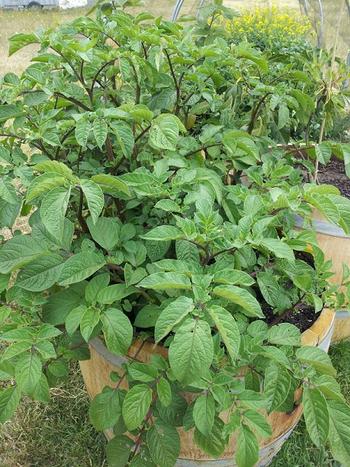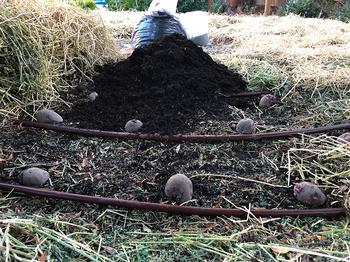Winter 2024
Potatoes are a Perfect Winter Crop!
by Robin Mitchell

In the relatively mild climate of Contra Costa County, and in particular on the San Francisco Bay side of the county, it is possible to grow potatoes almost all year. Know that if you grow potatoes, you will likely never harvest all the tiny potatoes, so you will potentially have potatoes in your garden "forever," as those will continue to grow and produce more potatoes!
Growing from “seed potatoes”
Potatoes are generally grown using what are called “seed potatoes," which are just parts of a potato that have been grown specifically for growing more potatoes. While it is possible to grow a potato from one bought in the grocery store, it may not produce that well and may carry diseases that will be added to your soil.
So the best practice is to buy “certified” seed potatoes from a reputable local nursery or online supplier. Most of the major seed suppliers in the United States sell certified seed potatoes.
Interestingly, if you try to grow potatoes from the actual seeds produced by the flowers, the genetic diversity is so high that you are unlikely to grow anything that resembles the potatoes that we are accustomed to eating.
Varieties
The potato varieties that are available from nurseries and online seed suppliers are quite impressive. Just looking at one organic seed supplier’s website, there are eighteen varieties. These include the well-known potatoes such as russets and gold potatoes, but also include varieties such as ‘Adirondack Blue Potato,’ ‘French Fingerling Potato,’ ‘Russian Banana Fingerling Potato,’ and the ‘Magic Molly Potato,’ which is a fingerling potato purple all the way through!
There are determinate and indeterminate potato varieties. Determinate varieties mature earlier, require less space, and generally produce smaller tubers. Indeterminate varieties are slower growing, but the yield is higher and the potatoes larger. This growth type is not always indicated in the potato descriptions, so you may need to get further information from the supplier.
Crop Rotation
Potatoes are in the nightshade (Solanaceae) family, which includes tomatoes, eggplants, and peppers, and they are all susceptible to the same pests and diseases. So if you plant the same family of crops in the same spot every year, such as rotating between potatoes and tomatoes, you will increase the likelihood that at some point there will be a year when the plants succumb to disease. It is recommended that you not plant in the same area with the same family more than once every three to four years.
When to plant
Potatoes prefer cool, moist weather, so the timing of planting will depend on what part of Contra Costa County you plan to grow the potatoes. The San Francisco Bay side of the county has much milder summers, and potatoes can be grown there in the summer and the winter. On the east side of the East Bay Hills, where it is colder in the winter and warmer in the summer, the growing season might be more constrained.
In general, potatoes can be planted either starting in February (in coastal regions of the county) or March (for inland areas of the county) through August. You can plant mid-month during those times for a continual harvest.
The article “Potatoes in Raised Beds” by Earlene Miller, UC Master Gardener of Contra Costa County, says, “Seed potatoes can be planted from February through April, and a second crop can be planted in July or August."
Methods of growing
One of the primary considerations when growing potatoes is to make sure that the new potato tubers are not exposed to sunlight, which will turn them green. The green parts of a potato are toxic to eat. However, if the green areas of the potato are removed or not consumed, the rest of the potato is safe to eat. Commercial potato growers plant the potatoes in trenches and then add soil as they grow (hill them up) to make sure that they are covered.
When you buy seed potatoes, they are generally a whole potato with many “eyes” where the roots and stems will emerge. You should cut those potatoes into pieces, generally with at least 2 “eyes” per piece. Let them scar over in the open air (in the shade or inside) for a few days. Then they are ready to plant.
They will need to be planted in a place that gets at least 4-6 hours of direct sun each day.
Containers and Raised Beds

The container or bed should be at least 12 inches deep and filled to at least 6 inches with a good planter mix and lots of compost.
See this article, Potatoes in Raised Beds from the UC Master Gardener Program, Contra Costa County.
No-dig, deep mulch method
With this method, plant your seed potato pieces by placing each seed tuber cut-side down into the soil beside a source of water, such as an irrigation emitter or a space that you can hand-water at least once a week. You could also add a balanced organic fertilizer if desired.
Then cover the entire area with compost and a deep (8 inches or more) layer of straw mulch. When the potatoes are ready to harvest, you can remove the mulch, and you should have a large number of potatoes to pick.
Here is an article from the UC Master Gardeners Solano County blog about this method.
Direct Planting in the Ground
Remember that potatoes like well-drained sandy loam soil, and they will rot under prolonged cold, wet conditions. If your soil drains poorly or is heavy clay, consider the two methods described above.
If your soil is conducive to growing potatoes, one of the standard methods is to grow in trenches or furrows that are about 3 feet apart. But they can also be grown in individual hills or mounds.
If planting in a furrow, dig it to approximately 6-8 inches deep, place the potato seed tubers about 1 foot apart, and then cover them with several inches of soil. As the shoots grow, fill in around them to ground level. Seed potatoes can be placed as close as 6 inches or as far apart as 1 ½ feet apart, but the closer spacing will result in smaller potatoes.
When the stems are approximately 4” tall, continue to add soil around them, which is known as "hilling." This mounded soil, as well as compost, mulch, or straw, will keep them from turning green by protecting them from sunlight
Watering

Stop watering when the plant turns yellow and starts to die back, or several days to one week prior to harvesting the entire crop.
Harvesting
You can begin harvesting small, early potatoes when the plant starts to flower or the flowers begin to fade. If you wait until the foliage turns yellow or dies completely, you will harvest bigger potatoes. Be careful when harvesting, particularly if you are using a digging tool, not to injure the tubers. Harvesting can be spread out over a few weeks, but don’t leave them in the ground for long periods after the optimum harvest, or they may start to rot.
Storage
Store potatoes in a cool, well-ventilated place, and make sure that they are not exposed to light. It is best to use them within six weeks for good flavor and texture.
Resources
Growing Potatoes at Home, video by Andrea Salzman
https://www.youtube.com/watch?v=tnWrn1XscD0
Growing Potatoes Organically (UC Davis Trials)
https://vric.ucdavis.edu/pdf/organic_potatoes.pdf
Grow Potatoes the Easy Way with Deep Mulch (Solano County Master Gardener Program)
https://ucanr.edu/blogs/blogcore/postdetail.cfm?postnum=51911
No Digging Needed to Grow Potatoes (UC Marin Master Gardeners)
https://marinmg.ucanr.edu/ASK_US/EDGNOVATO/News/?story=2443
- Pests in Gardens and Landscapes, UC IPM
Cultural Tips for Growing Potato
https://ipm.ucanr.edu/home-and-landscape/potato/cultural-tips/index.html?src=307-pageViewHLS - Potato - Solanum tuberosum
https://ipm.ucanr.edu/home-and-landscape/potato/index.html
Potato Growing Tips (Tulare/Kings Canyon Master Gardener Program)
https://ucanr.edu/datastoreFiles/268-265.pdf
Potatoes (Sonoma County Master Gardener Program)
https://sonomamg.ucanr.edu/Food_Gardening/Feature_Vegetables/Potatoes
Potatoes in Raised Beds (Contra Costa County Master Gardener Program)
https://ucanr.edu/sites/ccmg/files/103002.pdf
Potatoes in Your Garden (UCANR Stanislaus County)
https://ucanr.edu/sites/CEStanislausCo/files/111746.pdf
Vegetable Planting Guide for Coastal Regions
https://ccmg.ucanr.edu/files/131285.pdf
Vegetable Planting Summary (Sonoma County Master Gardener Program)
https://sonomamg.ucanr.edu/files/30787.pdf
